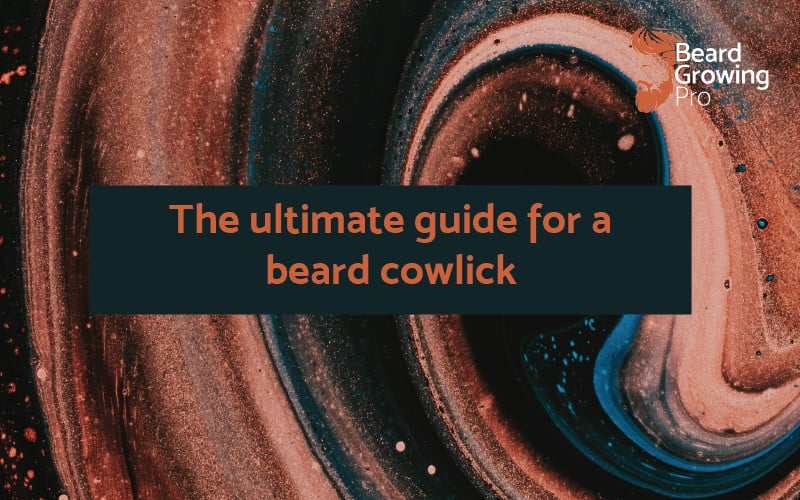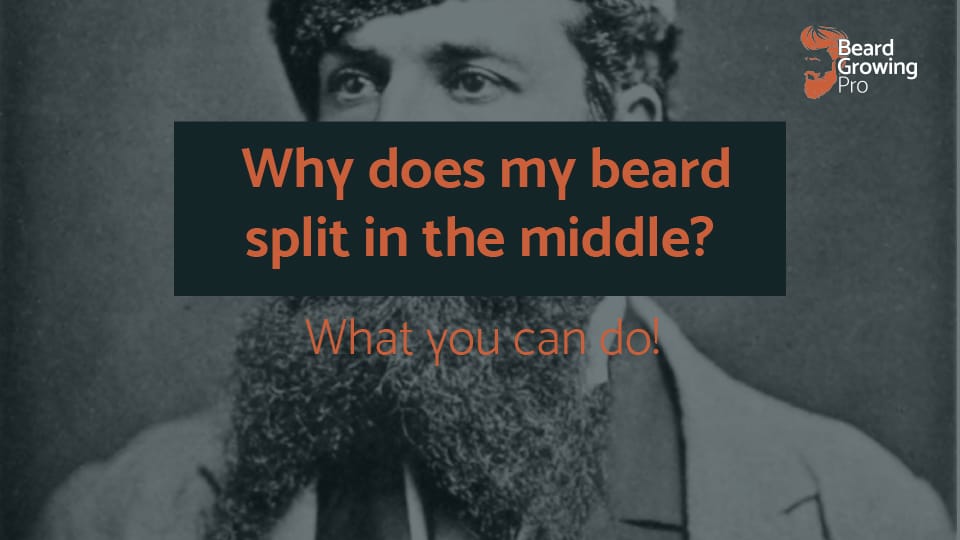A beard cowlick is something very difficult and annoying to deal with. Having a spiral in your beard and a pattern of growth fixed in a circular form quickly ruins the lines and shape. Perhaps you have tried shaving off, dousing it in all sorts of products, or maybe you have accepted that this natural imperfection is something that gives you a personal style, and you have embraced it fully.
You can minimize the look of a beard cowlick by using products with hold and growing out your beard. It is common for cowlicks to appear on the jaw and neck area, although it can happen anywhere on your beard.
If you are on the unlucky end of the beard cowlick spectrum, you may have more than one interfering with each other. The presence of many adjacent beard cowlicks makes it even harder to control.
This article will go over everything you need to know about beard cowlicks, what you can do about them, and anyway that can help train the hair to grow in the direction you need it to grow in.
If you are a visual learner, check out my YouTube video on fixing a beard cowlick:
These cowlicks can appear as circular formations of hair, or they make also look like elongated swirls. Their exact cause is very simple to explain. Let’s take a look at that now.
Why do I have a swirl in my beard?
Like a cowlick on your head, a swirl (or cowlick) is created by the direction your hair follicles point. This swirl results from the hair growing in the direction that the follicle is pointing. The direction can be almost parallel to the skin’s surface.
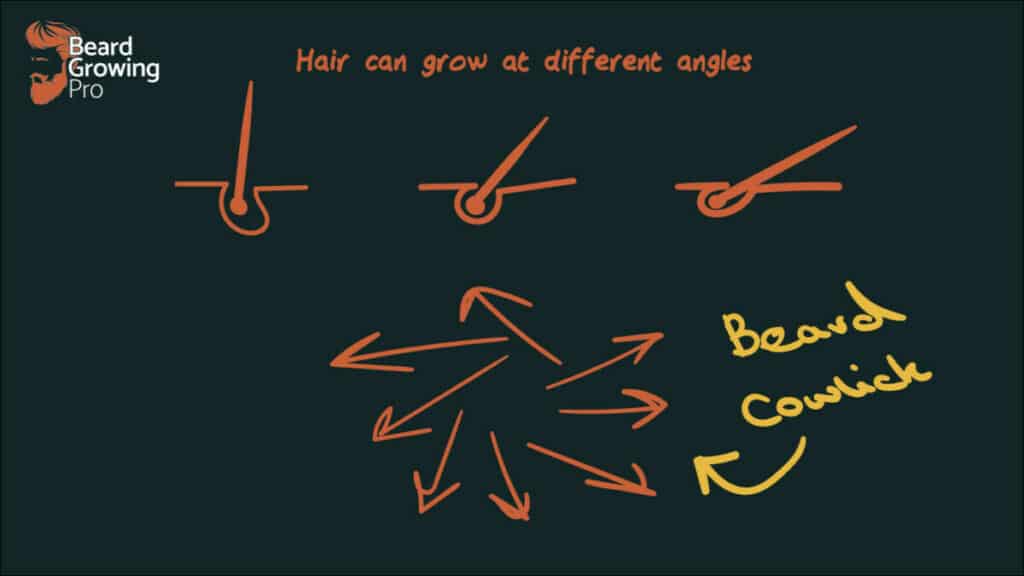
The issue is that hair, particularly beard hair, takes a while to get long enough to be held in a certain position.
When you have short hair, it is rigid and straight to her than if it grows out more. In the early days, there isn’t much that you can do about it other than push through any awkwardness you feel and let the cowlick grow out so that the weight of the hair slowly pulls the cowlick into a position that better suits the surrounding hairs.
There are a few options for getting rid of beard cowlicks. But, be warned, it will probably take a fair bit of patience and persistence to correct properly.
Now, let’s take a look at all of how you can get rid of your beard cowlick.
How to get rid of my beard cowlick?
Beard cowlicks are ultimately due to the direction of the hair follicles. The direction of your follicles is determined by your genetics and the growth patterns that your hair takes.
Beard cowlicks are particularly noticeable in the early stages of beard growth because the hair has not got long enough to become flexible. It sticks straight out in the direction of growth.
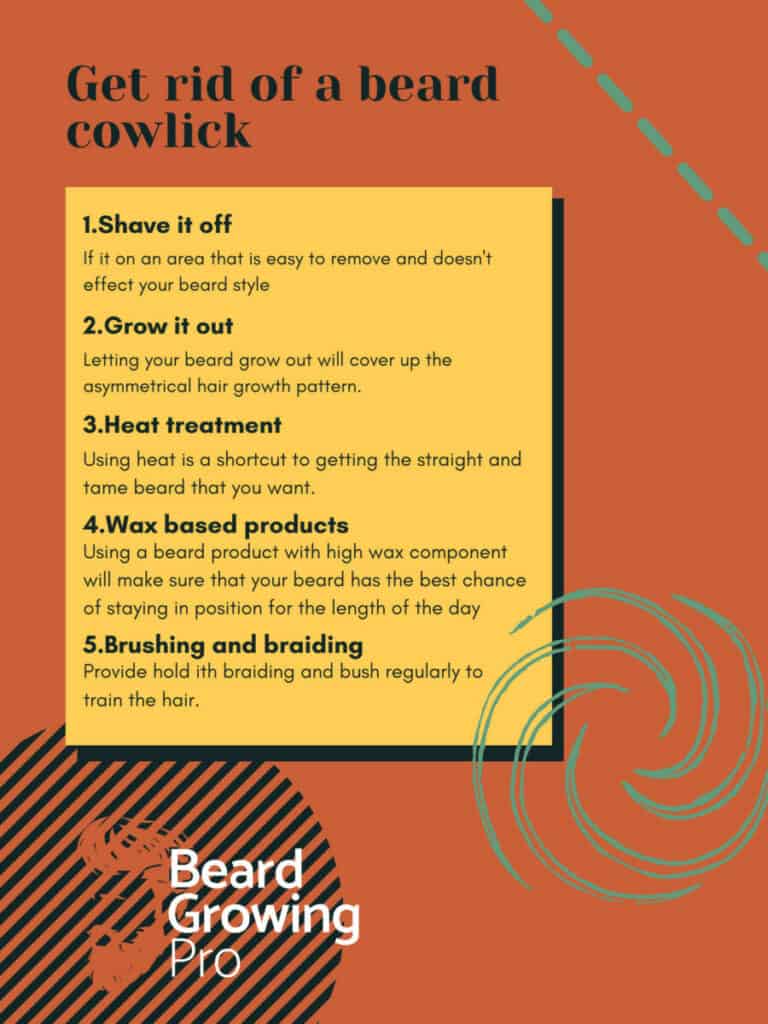
There is not much you can do to change the direction of your hair follicles.
Here are the other ways that you can fight the pesky beard cowlick:
Shave it off
One of the first things you should consider is whether or not shaving the affected area is the right solution for your beard. If your cowlick appears on the neck or under the jaw, you could completely trim it off.
Shaving your beard off is an extreme option for a cowlick that is in a place where you do not want to grow hair.
The style of your beard will dictate whether or not you can shave your beard in that area.
Or, you could potentially look at beard styles that do not have hair in the area of your beard cowlick or swirl.
However, for many men, this is not an option as the swirl or cowlick appears in a place where they want to keep the hair. In that instance, the only thing you can do is to grow it out to see if the extra length can hide the swirl.
Grow it out
The next option – which is the most simple – is to grow it out. When growing a beard, it is common for men to immediately identify what is wrong and then try to avoid it from growing any further.
In many instances, letting your beard grow out will cover up the asymmetrical hair growth pattern.
Growing out your beard straightens out the hair because the extra weight is pulled down by gravity. The hair has to get to a certain length before being trained into a certain position.
When hair is very short, i.e. like stubble, it can only sit in one direction. Also, growing your hair may allow the hairs around or above the cowlick to cover it up. It’s not until your hair gets to about 2 to 4 months in length that it can cover up any problem areas.
If you find that you have a cowlick, this should be one of the first things that you do – wait at least three months before deciding whether or not you should use a more aggressive intervention for shaping your beard hair and taming the cowlick.
After growing the hair out, the next stage is to use heat treatment to keep the hair in position.
Heat treatment
When we talk about heat treatment for beards, we mean hot blow dryers and straighteners.
It is very common for people to straighten their beards with heat. Using too much heat can cause a fair amount of damage to your beard, but in the instance of a cowlick, it may be the perfect intervention for your unruly hair growth.
Check out my YouTube video where I talk about should you straighten your beard? The insider pros, cons, and tips:
Using heat is a shortcut to getting the straight and tame beard that you want. There is no reason that you shouldn’t straighten your beard every day.
However, if you use a straightener on high heat for more than a couple of days in a row, it can leave your beard dry, full of split ends, and frizzy.
Make sure that you use heat treatment in a conscious and balanced way, which means you’ll get the best of both worlds.
Beard straightening works because the curls in your beard are held together by sulphur to sulphur bridges in the hair’s protein.
Heat treatment breaks that sulphur bond and causes it to reform in a straight position. Anyone that has used a beard straightener realizes that as soon as you get your beard wet, it will go back to its natural state, which may be curly. So you have to straighten your beard every time you shower or your beard gets wet.
How to straighten your beard
It is very simple to straighten your beard is as simple as using your preferred heat application technique (either hot air or a beard straightener) and combing the beard into shape as you go.
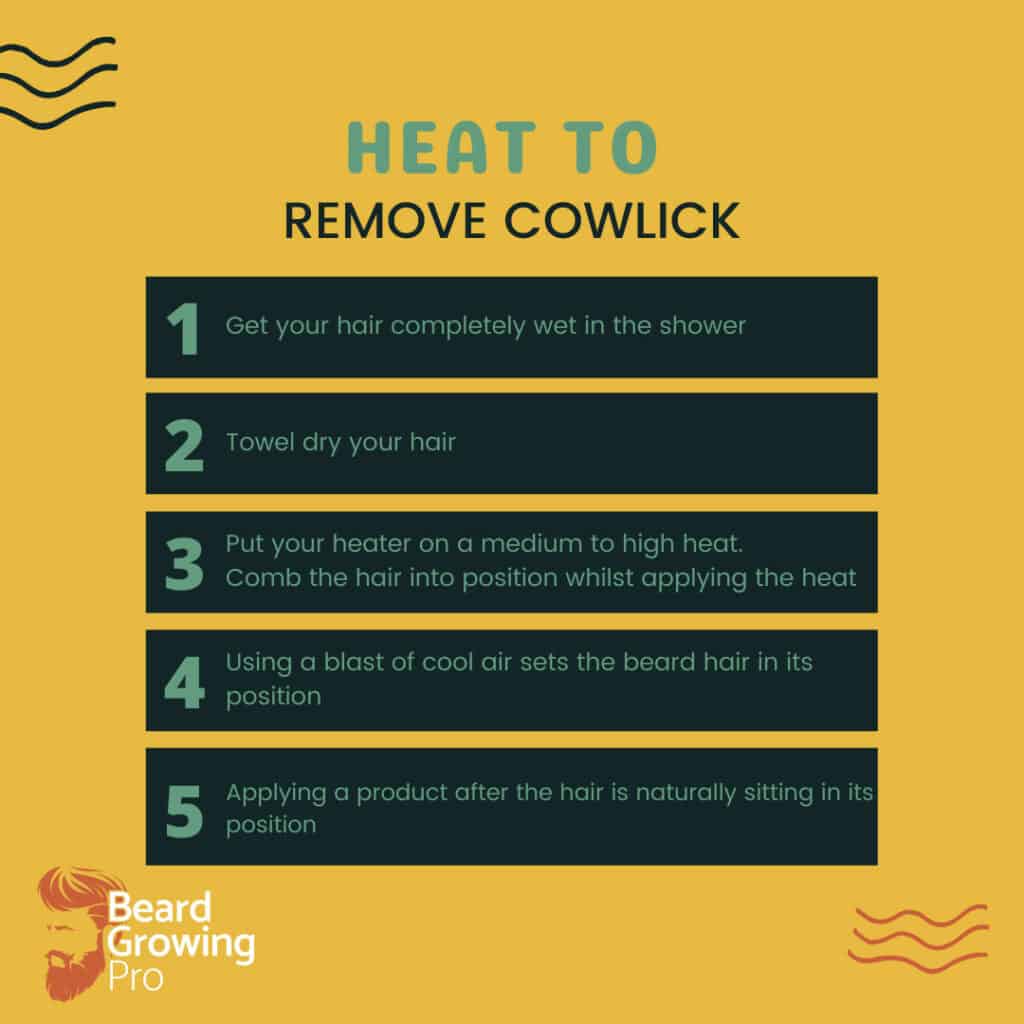
The process is very simple:
- get your hair completely wet in the shower – this resets your hair so that it is most receptive to beard straightening.
- Towel dry your hair – before blow-drying or using any heat treatment; you must towel dry your hair to remove most of the water.
- Put your heater on a medium to high heat – whether it is a beard straightener or a hot hairdryer, you have to use the highest heat that you can stand on your skin.
- Comb the hair into position whilst applying the heat – this is the most crucial stage as you need to tell the hair where to sit.
- Using a blast of cool air sets the beard hair in its position and cools the hair down, which means it is less likely to re-curl.
- Apply beard oil or wax – applying a product after the hair is naturally sitting in its position will help hold its position throughout the rest of the day.
- Dampen and rework problem areas – you may need to rework particularly bad areas with a cowlick by placing a damp towel over the affected areas and reworking with hot and cool air.
Using heat treatment is one of the most effective and cost-effective ways of treating a beard cowlick. Follow that up with some awesome beard products, and it may be the easiest way for you to hide your beard imperfections.
Trim the hairs that escape
There is something that makes a good beard great: trimming up the lines of the beard. The lines of the beard are what define the shape.
If there is any fuzziness around this line, it can look less well maintained than a beard with sharp lines.
If you have a cowlick that is causing hairs to escape the beard’s overall shape, you must trim up to maintain the shape.
That means that the area affected by the cowlick may be slightly shorter than the rest of your beard, but from a beard line perspective, it will keep it looking symmetrical on both sides.
If you want to see an example of how I trim up a beard at home, check out my YouTube video:
This video goes through everything you need to know about trimming your beard yourself. If you have any doubts about what you are doing or are uncomfortable with trimming your beard yourself, you can seek out the help of a professional barber.
Use beard products with high wax component
Using a beard product with a high wax component will ensure that your beard has the best chance of staying in position for the length of the day.
Personally, I like to use my DIY beard balm where I have a 50% wax component which is quite high compared to other beard balms. It is perfect for holding my beard in position, and you can see how I make it in my video below:
When you first start using beard products to control your cowlick, you properly want to start with the highest wax component that you can find.
A cowlick will require an extra hold that is not commonly found when looking for beard butter or beard balms.
Also, I would stay clear of beard oils for the area of your beard cowlick. Beard oils are great at softening the hair and conditions, but they provide no hold.
I would back up using a strong hold beard product with beard oil around the problem area.
If you find that the commercial beard products are not providing enough hold, I recommend that you learn to make your own.
If you can cook pasta, you can melt some beard wax components together to find and cultivate the best beard wax for your cowlick.
Brushing and braiding
There is no fighting how much your genetics determines your cowlick. But you can try to change the direction of the hair growth using brushing and braiding to hold the beard hairs in place.
Brushing
Some of the forums online recommend that brushing with a natural hair bristle brush for several months will help your hair grow in the direction you want.
In my personal experience, I’ve never been able to keep up with the routine of brushing my hair more than once a day, and so I can’t tell you whether or not this will work.
Some people online recommend that you train your beard to grow in a certain direction with regular brushing. If none of the above options works for you, there is certainly no harm in brushing your hair into a certain shape.
Braiding
if your beard is very long, you could try to cover up the cowlick by parading the hair in the cowlick with the hair around the cowlick.
This is a similar method if you try to stop a beard from forking. Go check out my other article – why does my beard split in the middle. For a rundown on exactly what you can do to tame wild hairs causing a fork – click here.
There are two ways that you can use braids:
- When drying your hair, you could use a braid to hold the beard in place while it air dries – and then undo the braid before you head out into the world.
- Keep a small or large braid in your hair during the day to hold the beard together. It doesn’t have to be very large (and obvious) to do a good job and keeping the two sides of the fork together.
Either of these options is worth trying if you feel like your hair needs a little more control!
Both of these options require that you are spending a little bit more time in the maintenance phase of your beard growth journey, but with persistence, these may both work for you.
One of the last options you have is to just accept that your beard is perfect the way it is and makes your beard unique to you.
Embrace the uniqueness of your beard
Embracing the uniqueness of your beard could be one of the best things you can do to make sure that your beard cowlick is a force for good.
As beard growers, we are always looking at our beards and working out what is wrong with them.
Constant criticism isn’t always the best way to approach your beard journey.
People are always looking for ways to stand out, and this cowlick may be the thing that makes your beard unique and stand out in a crowd.
Too many mental health problems are caused by comparison. Whether via social media sites such as Facebook and Twitter or Instagram and YouTube, the comparison is everywhere.
We are always being shown the best bits of everyone’s lives and beards. Embracing your beard cowlick and swells is nothing to be afraid of, and with the right mindset, there is no doubt that you can fall in love with it.
Before deciding that there is something wrong with your beard, ask yourself if the problem should be solved.
Can you permanently get rid of a cowlick?
I have not come across any evidence that suggests you can get rid of a cowlick permanently without removing the hair completely.
You can certainly minimize the effects of the cowlick on your beard using the techniques described above, but they are all temporary.
As soon as you wet your beard, the cowlick will return. The only real way to get rid of a cowlick is to extract the hairs and reinsert them using a follicular unit grafting into the right position.
Follicular unit grafting is a pretty invasive procedure and one that probably isn’t necessarily warranted for the issue of a cowlick in a beard.
Conclusion
So, there are all things you need to know about cowlicks in beards. There are a few things that you can do to temporarily reduce the effects of the beard cowlick on your styled beard.
You can use a combination of all of the above tricks to tackle a beard cowlick and any problem swirls that may appear as you are growing out your beard.
Remember that beard cowlicks are an issue in the earlier stages of beard growth and that simply growing your beard could be the first mode of attack on any problem area.
Embracing your uniqueness and not worrying about what other people think is a key tool you can use to make sure that you remain in love with your beard.

